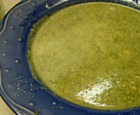|
Caribbean Side-Soup Callaloo Soup Sent in by Cathy Bibbs-Cornell:
Cook the celery, onions, garlic and sweet pepper in butter until tender. Add all remaining ingredients. Simmer until all the vegetables are soft, about 30 minutes. Puree soup in a blender in small batches, until smooth and free of lumps. Serve! To our readers: Also check out Cathy's recipe for Curacço Stew. |
Tips & Glossary Caribbean cuisine is an exquisite blend of African, Asian, European, and Carib Indian (the area's original inhabitants) foods. Dishes are highly seasoned, either with a dry rub or marinade —or both. Below are some typical ingredients found in Caribbean food. Callaloo: young leaves of either the taro root plant or amaranth; used widely in Caribbean cooking. Spinach can be used as a substitute. Spices: Allspice, bay leaves, black pepper, chives, chili peppers, cilantro, cinnamon, coconut, curry powder, escallion, garlic, ginger, lime, mace, nutmeg, onion, oregano, sugar, thyme, orange, tomato paste, vanilla, cayenne (red) pepper. Jerk: Jamaican cooking method in which meat is rubbed, prior to grilling, with a blend of seasonings, often firey hot. • 1 T each—onion powder, garlic powder, dried chives, brown sugar; 2 tsp. each— (ground) allspice, nutmeg, cinnamon; 1 tsp. each—sage. thyme, salt, black pepper, cayenne (or more to taste). Mix thoroughly and store in a tightly covered jar. There are thousands of versions; figure out what flavors you like most and add or subtract accordingly. Typical meats: goat, pork, chicken, and some beef (though beef has tended to be expensive). Fish: varieties that abound in surrounding waters, some familiar to us—grouper, cod, tilapia, blue marlin; others not so—200 species of jack, chip-chips (tiny clams), casadura (primitive armored catfish). Native plant foods: More familiar foods:
|

